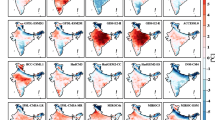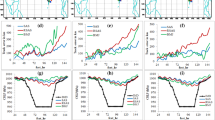Abstract
The simulation of the Asian monsoon rainfall and its extreme events with high fidelity remains a challenge even for the present day state-of-the-art models with conventional treatment of convection. A multi-scale approach vis-à-vis the super-parameterization appears to overcome the uncertainty of convective parameterization and thereby improve models ability to simulate rainfall. In this study, performance of super-parameterized community climate system model’s atmospheric only (SPCAM) forced with observed SST and coupled (SPCCSM) versions have been evaluated to capture Indian summer monsoon rainfall characteristics. Analyses show that, simulation of rainfall and its extremes are better represented in the atmospheric model (SPCAM) over the Indian landmass. This is largely because of better representation of convection in the uncoupled version. It is also observed that 2–10 day synoptic mode of the summer monsoon has a large variance over Indian region which may be broadly responsible for extreme events, and SPCAM captures this synoptic variability reasonably well. Our study also indicates that models may have poor moisture holding capacity. This problem is more prominent in SPCCSM.













Similar content being viewed by others
References
Ajayamohan R S, Merryfield W J and Kharin V V 2010 Increasing trend of synoptic activity and its relationship with extreme rain events over central India; J. Clim. 23, https://doi.org/10.1175/2009jcli2918.
Allan R P, Soden B J, John V O, Ingram W and Good P 2010 Current changes in tropical precipitation; Environ. Res. Lett. 5 025205.
Allen M R and Ingram W J 2002 Constraints on future changes in climate and the hydrologic cycle; Nature 419 224.
Alexander L V et al. 2006 Global observed changes in daily climate extremes of temperature and precipitation; J. Geophys. Res. 111 D05109, https://doi.org/10.1029/2005JD006290.
Benedict J J and Randall D A 2009 Structure of the Madden–Julian Oscillation in the super-parameterized CAM; J. Atmos. Sci. 66 3277–3296, https://doi.org/10.1175/2009JAS3030.1.
Collins W D et al. 2004 Description of the NCAR Community Atmosphere Model (CAM3); Technical Report. NCAR/TN-464 STR, National Center for Atmospheric Research, Boulder, CO, 226p.
Collins W D et al. 2006 The community climate system model version 3 (CCSM3); J. Clim. 19 2122–2143.
Dee D P et al. 2011 The ERA-Interim reanalysis: Configuration and performance of the data assimilation system; Quat. J. Roy. Meteorol. Soc. 137 553–597, https://doi.org/10.1002/qj.828.
DeMott C A, Randall D A and Khairoutdinov M 2007 Convective precipitation variability as a tool for general circulation model analysis; J. Clim. 20 91–112, https://doi.org/10.1175/JCLI3991.1.
Duchon C E 1979 Lanczos filtering in one and two dimensions; J. Appl. Meteorol. 18 1016–1022, https://doi.org/10.1175/1520-0450.
Durman C F, Gregory J M, Hassell D C, Jones R G and Murphy J M 2001 Comparison of extreme European daily precipitation simulated by global and a regional climate model for present and future climates; Quat. J. Roy. Meteorol. Soc. 127 1005–1015, https://doi.org/10.1002/qj.49712757316.
Easterling D R and Evans J L et al. 2000 Observed variability and trends in extreme climate events: A Brief Review; Bull. Am. Meteor. Soc. 81(3).
Frich P et al. 2002 Observed coherent changes in climatic extremes during the second half of the twentieth century; Clim. Res. 19 193–212.
Gadgil S and Gadgil S 2006 The Indian monsoon, GDP and agriculture; Econ. Polit. Wkly 41(47) 4887–4895.
Gates W L, Boyle J, Covey C, Dease C, Doutriaux C, Drach R, Fiorino M, Gleckler P, Hnilo J, Marlais S, Phillips T and Potter G et al. 1998 An overview of the results of the atmospheric model intercomparison project (AMIP I); Bull. Am. Meteor. Soc. 73 1962–1970.
Gordon H B, Whetton P H, Pittock A B, Fowler A M and Haylock M R 1992 Simulated changes in daily rainfall intensity due to the enhanced greenhouse effect: Implications for extreme rainfall events; Clim. Dyn., https://doi.org/10.1007/BF00209165.
Goswami B N, Venugopal V, Sengupta D, Mdhusoodanan M S and Prince K X 2006 Increasing trend of extreme rain events over Indian in a warming environment; Science 314 1442–1445.
Grabowski W W 2001 Coupling cloud processes with the large-scale dynamics using the cloud-resolving convection parameterization (CPCP); J. Atmos. Sci. 58 978–997.
Hennessy K J, Gregory J M and Mitchell J F B 1997 Changes in daily precipitation under enhanced greenhouse conditions; Clim. Dyn. 3 667–680.
Houze R A Jr 1989 Observed structure of mesoscale convective systems and implications for large-scale heating; Quat. J. Roy. Meteorol. Soc. 115 425–461.
Huffman G J, Adler R F, Bolvin D T, Gu G, Nelkin E J, Bowman K P, Stocker E F and Wolff D B 2007 The TRMM multisatellite precipitation analysis: Quasi-global, multi-year, combined-sensor precipitation estimates at fine scale; J. Hydrometeorol. 8 33–55.
Hurrell J W, Hack J J, Shea D, Caron J M and Rosinski J 2008 A new sea surface temperature and sea ice boundary dataset for the community atmospheric model; J. Clim. 21 5145–5153.
Iorio J P, Duffy P B, Govindasamy B, Thompson S L, Khairoutdinov M and Randall D 2004 Effects of model resolution and sub-grid scale physics on the simulation of precipitation in the continental United States; Clim. Dyn. 23 243–258, https://doi.org/10.1007/s00382-004-0440-y.
Jakob C and Schumacher C 2008 Precipitation and latent heating characteristics of the major tropical western Pacific cloud regimes; J. Clim. 21 4348–4364.
Khairoutdinov M and Randall D A 2001 A cloud resolving model as a cloud parameterization in the NCAR community climate system model: Preliminary results; Geophys. Res. Lett. 28 3617–3620.
Khairoutdinov M, Randall D A and DeMott C A 2005 Simulation of the atmospheric general circulation using a cloud-resolving model as super-parameterization of physical processes; J. Atmos. Sci. 62 2136–2154.
Krishnamurthy V and Stan C 2015 Simulation of the South American climate by a coupled model with super-parameterized convection; Clim. Dyn., https://doi.org/10.1007/s00382-015-2476-6.
Li F, Collins W D, Wehner M F, Williamson D L and Olson J G 2011 Response to precipitation extreme to global warming in an aqua planet climate model: Towards robust projection from regional to global scales; Tellus, Ser. A 63(5) 876–883, https://doi.org/10.1111/j.1600-0870.2011.00543.x.
Li F, Rosa D, Collins W D and Wehner M F 2012 Super-parameterization: A better way to simulate regional extreme precipitation? J. Adv. Model. Earth Syst. 4 M04002, https://doi.org/10.1029/2011MS000106.
Liebmann B and Smith C A 1996 Description of a complete (interpolated) outgoing longwave radiation dataset; Bull. Am. Meteor. Soc. 77 1275–1277.
Min S K, Zhang X, Zwiers F W and Hegerl G C 2011 Human contribution to more-intense precipitation extremes; Nature 470(7334) 378–381.
Oouchi K A, Noda T, Satoh M, Wang B, Xie S P, Takahashi H G and Yasunari T 2009 Asian summer monsoon simulated by a global cloud-system-resolving model: Diurnal to intra-seasonal variability; Geophys. Res. Lett. 36 L11815, https://doi.org/10.1029/2009GI038271.
Paul S, Ghosh S, Oglesby R, Pathak A, Chandrasekharan A and Ramsankaran R 2016 Weakening of Indian summer monsoon rainfall due to changes in land use land cover; Scientific Reports 6 32177, https://doi.org/10.1038/srep32177.
Rajeevan M and Bhate J 2008 A high resolution daily gridded rainfall data set (1971–2005) for mesoscale meteorological studies; National Climate Centre Research Report (9).
Rajeevan M, Bhate J and Jaswal A K 2008 Analysis of variability and trends of extreme rainfall events over India using 104 years of gridded daily rainfall data; Geophys. Res. Lett. 35 L18707, https://doi.org/10.1029/2008GL035143.
Singh D, Tsiang M, Rajaratnam B and Diffenbaugh N S 2014 Observed changes in extreme wet and dry spells during the south Asian summer monsoon season. Nat. Clim. Change, https://doi.org/10.1038/NCLIMATE2208
Sikka D R and Gadgil S 1980 On the maximum cloud zone and the ITCZ over Indian longitudes during southwest monsoon; Mon. Wea. Rev. 108 1840–1853.
Sharmila S, Pillai P A, Joseph S, Roxy M, Krishna R P M, Chattopadhyay R, Abhilash S, Sahai A K and Goswami B N 2011 Role of ocean–atmosphere interaction on northward propagation of Indian summer monsoon intra-seasonal oscillations; Clim. Dyn., https://doi.org/10.1007/s00382-013-1854-1.
Trenberth K E, Dai A, Rasmussen R M and Parsons D B 2003 The changing character of precipitation; Bull. Am. Meteor. Soc. 84 1205.
Turner A G and Annamalai H 2012 Climate change and south Asian summer monsoon; Nat. Clim. Change 2 587–595, https://doi.org/10.1038/nclimate1495.
Vittal H, Ghosh S, Karmakar S, Pathak A and Murtugudde R 2016 Lack of dependence of Indian summer monsoon rainfall extremes on temperature: An observational evidence; Scientific Reports 6 31039, https://doi.org/10.1038/srep31039.
Wahl E R and Morrill C 2010 Toward understanding and predicting monsoon patterns; Science 328 437–438.
Xie Y B, Chen S J, Zhang I L and Hung Y L 1963 A preliminarily statistic and synoptic study about the basic currents over southeastern Asia and the initiation of typhoon (in Chinese); Acta Meteorol. Sin. 33 206–217.
Yasunari T 1979 Cloudiness fluctuation associated with the Northern Hemisphere summer monsoon; J. Meteorol. Soc. Japan 57(3) 227–242, https://doi.org/10.2151/jmsj1965.57.3_227.
Yasunari T 1980 A quasi-sationary appearance of 30–40 day period in the cloudiness fluctuation during summer monsoon over India; J. Meteorol. Soc. Japan 58(3) 225–229, https://doi.org/10.2151/jmsj1965.58.3_225.
Yasunari T 1981 Structure of an Indian summer monsoon system with around 40-day period; J. Meteorol. Soc. Japan 59(3).
Acknowledgements
The Indian Institute of Tropical Meteorology is fully funded by the Ministry of Earth Sciences, Government of India, New Delhi. The authors also thankful to Dr. Marat Khairoutdinov for the development of SP frame work and also providing the data and his suggestions. Authors would like to thank ‘Pratyush’ HPC support for necessary help.
Author information
Authors and Affiliations
Corresponding author
Additional information
Communicated by Kavirajan Rajendran
Rights and permissions
About this article
Cite this article
Goswami, T., Goswami, B.B., Krishna, R.P.M. et al. Evaluation of SP-CAM and SP-CCSM in capturing the extremes of summer monsoon rainfall over Indian region. J Earth Syst Sci 129, 116 (2020). https://doi.org/10.1007/s12040-020-1381-5
Received:
Revised:
Accepted:
Published:
DOI: https://doi.org/10.1007/s12040-020-1381-5




